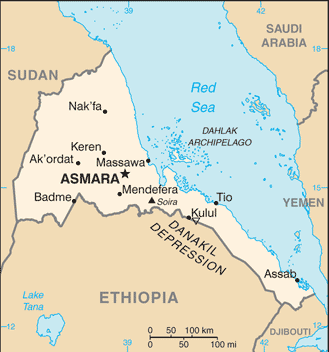Welcome to the Virtual Education Wiki ~ Open Education Wiki
Eritrea: Difference between revisions
(changed Pangaea to "Country" and adjusted collations - and added cat e-World) |
(CSV import all low-income countries, except Yemen done manually already) |
||
| (4 intermediate revisions by 2 users not shown) | |||
| Line 96: | Line 96: | ||
> [[Countries]] | > [[Countries]] | ||
<br> | <br> | ||
[[Category:Africa]] | [[Category:Africa]] | ||
[[Category:Sub-Saharan Africa]] | [[Category:Sub-Saharan Africa]] | ||
[[Category: | [[Category:French-speaking countries]] | ||
[[Category:e-World]] | [[Category:e-World]] | ||
[[Category:Country reports]] | |||
[[Category:Countries with Programmes]] | |||
[[Category:VISCED]] | |||
{{Countries-footer}} | |||
{{United Nations}} | |||
{{low-income}} | |||
Latest revision as of 16:36, 10 May 2023
Experts situated in Eritrea
Eritrea in a nutshell

Eritrea (Ge'ez: ኤርትራ ʾErtrā, Arabic: إرتريا Iritriya), officially the State of Eritrea, is a country in the Horn of Africa. It is bordered by Sudan in the west, Ethiopia in the south, and Djibouti in the southeast.
The east and northeast of the country have an extensive coastline on the Red Sea, directly across from Saudi Arabia and Yemen.
The Dahlak Archipelago and several of the Hanish Islands are part of Eritrea.
Its size is just under 118,000 km2 (45,560 sq mi) with a population of 5,939,484 (CIA July 2011 est.)
The capital is Asmara.
Following a UN-supervised referendum in Eritrea dubbed UNOVER in which the Eritrean people overwhelmingly voted for independence from Ethiopia, Eritrea declared its independence and gained international recognition in 1993.
English is used in the government's international communication and is the language of instruction in all formal education beyond the fifth grade.
Education in Eritrea
The school year runs September to June, consisting of 200 days. Schools in the lowlands area operate a six day week in order to finish before the hottest season.
Education is well organized in Eritrea. Tuition is subsidized by the government and studies relevant to the development of Eritrea are their main focus.
School-level education
Primary and middle school consists of eight years of compulsory education. [2]
Pre-primary Early education is largely a community responsibility, the government providing support through policies, programs and teacher training activities. Pre-schools are found generally in urban areas.
Primary level Lasting for five years, the official starting age is seven, but in practice the majority of students are older. This elementary education is supplemented by two further years of 'middle school', completing was is called 'basic formal primary education'.
Secondary level Secondary education is a four year program. There are two types of secondary schools -Science and Commerce. At the conculions of secondary level, students take the Eritrean School Leaving Certificate Examination (ESLCE), given once a year in March.
Instruction in middle and secondary classes is in English.
Further and Higher education
Universities in Eritrea
- The University of Asmara
Polytechnics in Eritrea
Colleges in Eritrea
- The Pavoni Technical Institute (PTI)
- The Asmara Commerce and Business Institute
Education reform
Administration and finance
Quality assurance
Information society
ICT in education initiatives
Virtual initiatives in schools
Virtual initiatives in post-secondary education
Lessons learnt
References
For OER policies and projects in Eritrea see Eritrea/OER